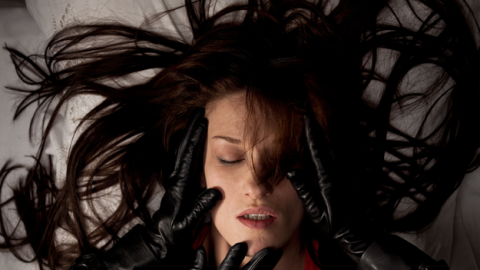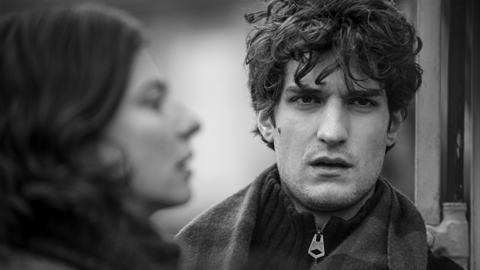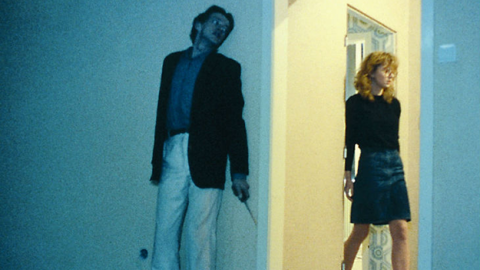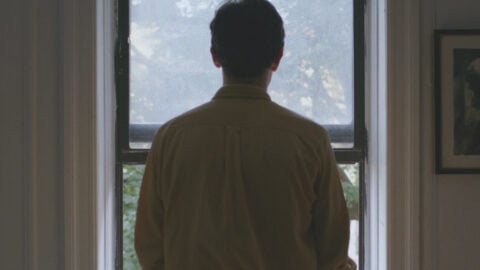Film of the Week: Let the Corpses Tan

Back in the ’80s, they used to call it cinéma du look. But the hyper-artificed, jazzy stylings favored by Hélène Cattet and Bruno Forzani are so extreme that they make the polished images of Jean-Jacques Beineix, Luc Besson, and their peers look as if they were knocked out by Dogme practitioners on a rushed schedule. Moreover, the Belgian-based French duo, who made their name with 2009 giallo tribute Amer, are more concerned with editing patterns than their look forebears, and way more casual about story. Their last film The Strange Color of Your Body’s Tears (2013), a pop-Gothic mash-up of Argento and Harry Kümel, made little narrative sense, but oh those screaming hues, those macabre leitmotifs, and the kinetic rhythms with which they popped your eyeballs.
Moving from ’70s-style erotic horror to ’70s-style erotic thriller, the duo pursue their retro-Euro genre obsession to new terrain in the new film Let the Corpses Tan (Laissez bronzer les cadavres), based on a 1971 novel by Jean-Patrick Manchette and Jean-Pierre Bastid, published under the legendary policier imprint Série Noire. In other words, there’s a coherent plot at work this time, although Cattet and Forzani are more cavalier with their sources even than the Nouvelle Vague directors when they got to work on the hard-boiled likes of Cornell Woolrich and David Goodis back in the ’60s. As for the stylistic freneticism of their previous two films, it’s hardly been diluted—which means that, to all intents and purposes, Let the Corpses Tan might as well make no sense at all. Anyway, the film is less about sense than effect—and the particular effect that Corpses aims for is a consistent, indeed relentless series of aesthetic gut punches.
The setting this time is a rocky, sun-baked stretch of Mediterranean coast—the film was mainly shot in Corsica—where a deserted village, complete with ruined church, is the home of Luce (Elina Löwensohn), a middle-aged painter with an exotic past and a defiantly who-cares attitude toward the present. Luce is presently playing hostess to her ex-lover, a washed-up novelist named Max Bernier (Marc Barbé, owner of the floppiest forelock in French cinema); her current beau, a seedy lawyer (Michelangelo Marchese); and three looming hoods. They are taciturn, cigar-puffing ringleader Rhino (Stéphane Ferrara); a portly, hairy-torsoed baldie (heavy rocker and sometime director Bernie Bonvoisin); and a young guy (Pierre Nisse) whose blank automaton glare is quickly established as one of the film’s more unnerving recurrent close-ups.
Plot? How much do you really need? Rhino and his boys pull a bullion heist and hide the bars on Luce’s domain. Soon after, two cops—one played by Dominique Troyes, better known as French porn veteran Marilyn Jess—come snooping around. Max’s young wife (Dorylia Calmel), their young son and their maid (Marine Sainsily) have paid a visit too. All hell breaks loose. But the specifics don’t matter very much: what’s essential, along with plentiful close-ups of cast members scowling menacingly to camera, is color, timing and sound.
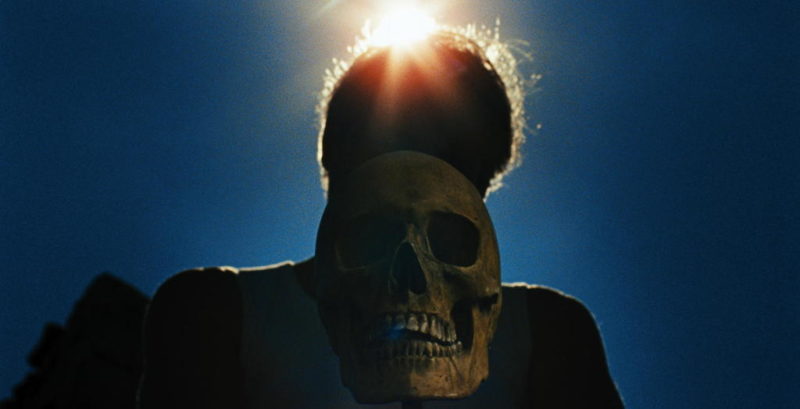
Cattet-Forzani literally splash their chromatic intentions on screen from the start: a series of introductory gunshots turns out to be Luce’s current working method, paint fired at a canvas. The paint motif runs through the film—there’s disconcerting visual play between the gold bars, gold paint on bodies, and golden sunlight; so much so that when we see the rich blue of the sea in a landscape shot, we could almost be seeing another luxurious paint spill. The virtuoso DP, shooting on Super-16, is Manu Dacosse, who shot François Ozon’s De Palma–fied Double Lover (2017), Lucile Hadzihalilovic’s Evolution (2016), and Joann Sfar’s handsome but inert remake of The Lady in the Car With Glasses and a Gun (2015)—a retro exercise in a very similar vein to Corpses but without an iota of its nerviness, or its perviness.
The directors, and editor Bernard Beets, proceed as if every image were fired at us from a gun barrel, and indeed they keep showing us close-ups of gun barrels, bullet holes, cigar-burned holes in canvases: yes, this is one of those thrillers that take the familiar play on “shots,” meaning both photography and gunfire, and run with it all the way. Some juxtapositions make you jump in a way that both Eisenstein and Russ Meyer would have loved: a burning cigar stub, an egg frying in close-up. There’s some gracefully snazzy cutting together of two characters swinging in hammocks, and the film observes the rule of cut-to-the-chase with bracing rigor: the cops’ bike ride to the main location is elided with a revving of motors and a close-up kick of a pedal, and, blam, they’re on the scene.
With sound editor Dan Bruylandt, the team have perfected the art of the super-staccato: they abruptly cut out through gunshots, screams, meat being chomped in close-up jaws. There’s fantastically tricky play with time, too. Intertitles provide precise countdowns of the action, but when the film’s inciting violent incident occurs, the action starts flitting backwards and forwards around a particular moment, the events retraced in precise detail from every possible angle in a sort of micro-Cubist ante-raising on the overlapping repetition technique of Pulp Fiction et al. This method doesn’t exactly deepen the narrative, but it quickens the pulse, and certainly strikes you as devilishly clever—as long as you feel inclined to figure out who’s where at any given moment, and who’s shooting at whom, from where.
The eroticism, in keeping with Cattet-Forzani’s previous two films, is ripe, baroque, and lascivious. Striding around in boots and miniskirt, her leathery features making her look like the debauched love child of Kim Gordon and Lee Van Cleef, Löwensohn’s character remembers her youth in the early ’70s or thereabouts, when she and Bernier shared artistic inspiration and orgiastic folies à deux. We’re talking naked art created by pissing, shooting, rolling in paint: it’s like a wild weekend organized by Yves Klein and a bunch of Viennese Actionists, with Alain Robbe-Grillet filming the proceedings. The results can be funny: “Got any rope?” asks a cop, triggering a surreal flashback involving crucifixion and champagne. A self-contained erotic sequence features the maid’s fantasy about the young scowling bandit shooting her dress to pieces, scrap by scrap.
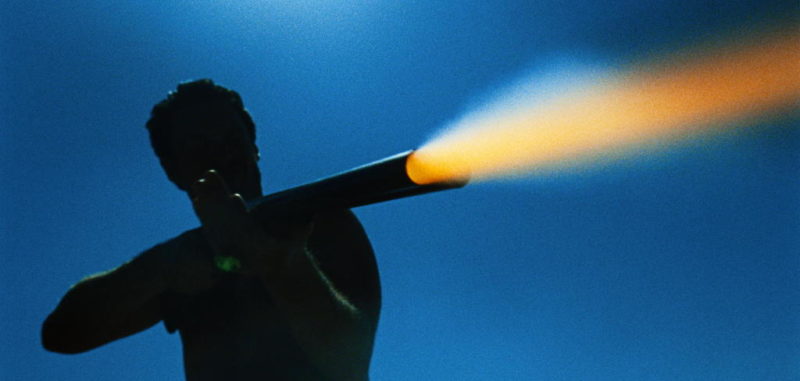
Corpses is drunkenly non-figurative, and there are so many images that jump out at you—and that may stick in your mind—that any sense of the film as an organic piece of cinema may fade into the background, as if Cattet-Forzani really cared. You want le look? Try Bonvoisin striding at night through a rainfall of blazing embers, or a series of shots that takes the impossible bullet-piercing-flesh inner-body close-up from David O. Russell’s Three Kings and melds it with some liquid-emulsion trickery. Similarly, characters don’t really figure in any way as real people, even by pulp thriller standards, more as visual effects: Rhino really comes into his own when repeatedly seen in close-up moodily chomping on a cigar while bathed in red light. A human skull, knocking around the estate as one of Luce’s props, can pretty much lay claim to being considered a character too, as can many of the film’s living people.
The wham-bam succession of staccato images is, it goes without saying, very like a comic strip—more precisely, like a French bande dessinée attempt to capture Sergio Leone in visual shorthand. Corpses is as much about sound as image; you almost expect to see written sound captions burst onto the screen. Clouds roll across the sky with a grinding rumble, like rolling boulders. There’s a chase sequence that cuts between a twinkly music-box waltz and a frenetic jazz drum solo. Meanwhile, the directors state their genre allegiances—a touch predictably—by using a selection of vintage Morricone, plus work by contemporaries Nico Fidenco and Stelvio Cipriani. Cattet-Forzani’s work is arguably the most thoroughly shamelessly sampled of any post-Tarantino genre-fixated fan cinema—yet they sample like rap producers do, in a way that’s entirely rhythmic, both visually and sonically to the point.
Just before the opening credits roll, some way into the film, the images switch to solarized textures in a psychedelic-era mode. But these visuals are so consistently exotic throughout, with every single image fetishized to the maximum, that Corpses is constantly in danger of turning not just into a music video (a familiar, but now outmoded, comparison for this kind of image-making) but into its own credit sequence. All respect, though, to Cattet-Forzani for melding their extreme aesthetic with at least some degree of narrative coherence, to more than intriguing effect. Their editing style is what you might call—in a variant of David Bordwell’s term for a contemporary Hollywood mode—“intensified discontinuity.” The wow factor is formidable, but the effect of visual orgasm after visual orgasm could well leave you profoundly jaded, or quickly forgetting what you’ve experienced. Not that Cattet-Forzani are unaware of this, it seems. After one particularly kinetic burst of action, the Barbé character, who’s missed it all, distractedly asks, “Did all that really happen while we were asleep?”
Jonathan Romney is a contributing editor to Film Comment and writes its Film of the Week column. He is a member of the London Film Critics Circle.



